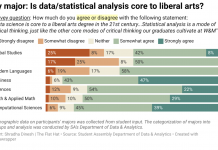Aspiring college students will have yet another tool at their disposal when they investigate their potential alma mater online. To provide clearer financial aid information for prospective students, U.S. President Barack Obama mandated that all colleges that receive federal aid to post a net price calculator on their websites by the end of October.
“We see this as an educational tool, and one which can help families,” College of William and Mary Associate Provost for Enrollment and Dean of Admission Henry Broaddus said.
In a time where economic recovery remains stagnant, the cost of attending a particular university is a guiding — if not the most significant — factor in choosing a college. The aim of the NPC is to give families a more accurate assessment of what they could be asked to pay, allowing them to make more informed decisions — and in the eyes of many, make more options available.
The idea is not a new one. The Higher Education Opportunity Act, signed in August 2008 by President George W. Bush, required colleges participating in Title IV student aid programs to make available a net price calculator on their financial aid websites.
While the College’s admission staff is quick to emphasize the beneficial potential of this calculator, its financial aid experts are not yet convinced. This springs from the fact that the NPC is simply a means of estimation, not a final analysis.
“The jury’s still out on the net price calculator,” Director of Financial Aid for the College Ed Irish said.
The College elected to use a calculator designed by the College Board, the same company responsible for the SAT and Advanced Placement programs. They maintain, as does the federal government, that this system will better inform those who use it by emphasizing gradually increasing net tuition prices instead of rapidly rising sticker tuition prices.
“It can help you widen your college choices beyond those institutions that you think you can afford,” the College Board website states. “It is possible that your net cost will be lower at a college with a high sticker price or higher at a college with a lower sticker price. You may find that some colleges you thought were financially out of your reach may be very affordable.”
College officials were not hesitant in pointing out flaws in the NPC system, as well as in the wider financial aid sphere as a whole.
“The problem is that, in so many states, higher education is so decentralized that in order to equip families to make comparisons, it must be standardized on some level,” Irish said. “Generally [the calculator] is accurate, but when it is off, it is way off — thousands of dollars off.”
The crux of the device’s potential problems is its estimating error. Users are cautioned to treat the appraisal provided by the program as simply that, and not to think of it as a final offer from that particular college.
Many factors go into considerations of financial need, which in the end determine the size of the award.
Both Irish and Broaddus firmly stated that the NPC should be given only a slight degree of importance when incoming students view colleges.
“It is a tool, but only one of many,” Irish said.
However, College officials still support the program in its intent to better educate potential students and their families.
“A college degree is a good investment in any economic situation,” Broaddus said.

































